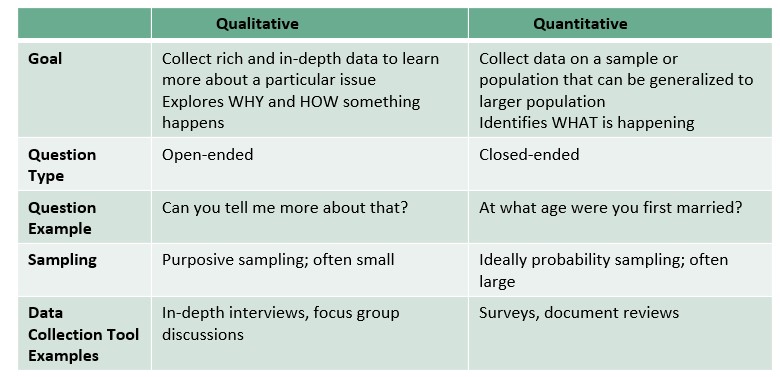Qualitative data can be summarized in pictures or words and collect rich and more in-depth data from fewer of people. They use open-ended questions and some form of interview technique (i.e. in-depth interviews, focus group discussions, or participatory methods). The data are primarily presented in words through narratives, verbatim quotes, descriptions, lists, and case studies or pictures.
Numerically, the findings of qualitative research are not generalizable but they can be more appropriate when the aim is to gain understanding about why and how something happens (Ellsberg & Heise, 2005). They are particularly appropriate when the aim is to understand a process about which not very much is known or when an issue is being studied for the first time in a particular setting. This can be useful in a conflict or post-conflict settings as qualitative results allow you to understand the nuances and details of complex social phenomena from the respondents’ point of view.

In addition to helping with understanding “why” something has occurred, using qualitative approaches before a research project can help inform, narrow down and contextualize the research project. Qualitative approaches can be employed in the following ways prior to the research project:
- To engage community stakeholders at the start of the research process (participatory methods) to contextualize the research
- To assess community needs
- To design an awareness campaign
- To plan interventions
- To design and test questionnaires
- When meaning is sought– to understand the mindset, perceptions, and attitudes of perpetrators, survivors, service providers, community members
Qualitative data collection uses purposive sampling; interview participants are chosen because they have the type of information the research questions seek to answer. For the sample size, less is more, and the aim is to work longer and in greater depth with a few key informants. Controlling bias is not as important because the researcher is a part of the process in which their view, opinions and interpretations are represented in the research. Therefore, while quantitative research is objective, qualitative research is inherently subjective. “In qualitative sampling, the selection of respondents usually continues until the point of redundancy (saturation). This means that when new interviews no longer yield new information and all potential sources of variation have been adequately explored, sampling may stop” (Ellsberg & Heise, 2005).
|
Box 8: Use of a Qualitative Study
In a study conducted by the London School of Hygiene and Tropical Medicine and the African Population and Health Research Centre, qualitative methodology was used to assess the effectiveness and impact of gender-based violence case management services in the Dadaab refugee camps. Data was derived from surveys and in-depth interviews with both GBV service staff and GBV survivors. Participants were interviewed by interviewers who received intensive training on GBV research and data collection, research ethics and good interviewing skills prior to the start of the data collection process. Research tools (i.e. survey and interview questions etc.) were thoroughly tested and revised to ensure ease of use, relevance, and to limit re-traumatization of participants. Impactful themes and quotations were extracted from the resulting interviews and used as evidence in subsequent analysis. Qualitative data was also used to relay the impact of GBV on the lives of women and girls and to support the researcher’s recommendations for action.
See more on the study: https://researchonline.lshtm.ac.uk/id/eprint/4647806/1/What%20Works%20Dadaab%20Report_LowRes.pdf |
